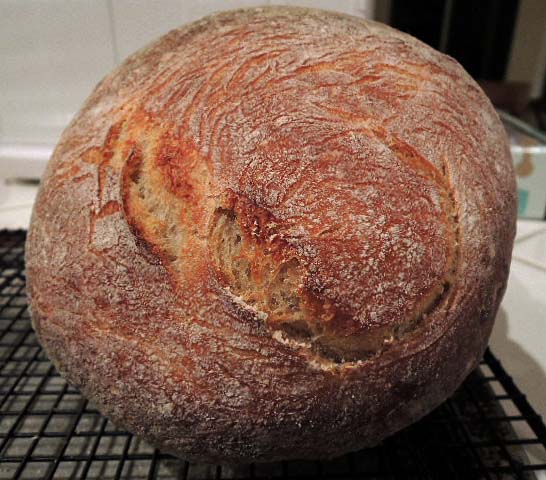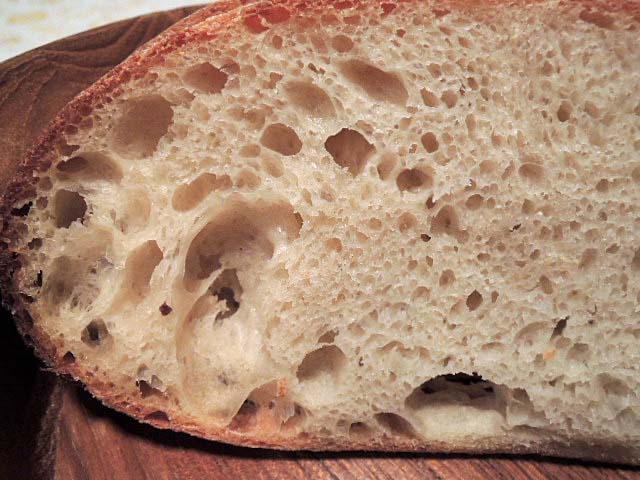
Pugliese Capriccioso, Take 3

In October, 2011, I baked a bread I called “pugliese capriccioso.” The formula was based on my best understanding derived from reading formulas in American books of what typical breads from Apulia are like. I baked another version, differing in the use of a firm starter (biga), in February, 2012. I remain unbiased by personal experience of the authentic bread, but the breads were good. Several other TFL bakers have made these breads, and all those reporting found them good as well.
More recently, I baked Hamelman's “Durum Bread,” which is 100% durum flour. I didn't like it as well as my pugliese, but my posting stimulated some interesting discussion regarding this type of bread and has prompted me to try a re-formulated pugliese capriccioso, using a higher percentage of durum flour.
My new formula uses a stiff biga made with bread flour (12.7% protein). Fifty percent of the flour is “fancy (finely milled) durum.” Forty percent of the flour is pre-fermented. Hydration is 80%
Total Dough Ingredients | Wt (g) | Baker's % |
Bread flour | 180 | 36 |
AP flour | 70 | 14 |
Fine durum flour | 250 | 50 |
Water | 400 | 80 |
Salt | 10 | 2 |
Active starter (50% hydration) | 36 | 7 |
Total | 946 | 189 |
Biga Naturale Ingredients | Wt (g) | Baker's % |
Bread flour | 180 | 100 |
Water | 90 | 50 |
Active starter (50% hydration) | 36 | 20 |
Total | 306 | 170 |
The day before baking, mix the biga.
Ferment for 8 hours at 70ºF.
Refrigerate overnight
Final Dough Ingredients | Wt (g) |
AP flour | 70 |
Fine durum flour | 250 |
Water | 310 |
Salt | 10 |
Biga naturale | 306 |
Total | 946 |
Method
Take the biga out of the refrigerator and let it warm up for about an hour.
Mix the water and flours to a shaggy mass, cover and autolyse for 20-60 minutes.
Sprinkle the salt over the dough and add the biga in chunks.
Mix at Speed 1 for 1-2 minutes until the ingredients are well-mixed.
Mix at Speed 2 for about 10 minutes. The dough will be quite slack. It will almost clean the sides of the bowl and form a ball on the dough hook, but a large portion of the dough will still be on the bottom of the bowl.
Transfer the dough to a lightly oiled bowl with a tight-fitting cover.
Ferment at 76ºF for 2 1/2 to 3 hours with a stretch and fold at 40, 80 and 120 minutes.
Divide the dough into two equal pieces. Pre-shape into balls and let the dough rest for 10 minutes to relax the gluten. (This wasn't much of an issue. The dough was extremely relaxed and extensible.)
Shape the pieces as tight boules and place them seam-side down in floured bannetons.
Place the bannetons in a food-safe plastic bag or cover with a damp towel. Proof the boules at 85ºF until the dough springs back slowly when you poke a finger into it. (About 2 hours)
45 minutes before baking, preheat the oven to 500ºF with a baking stone and steaming apparatus in place.
Transfer the loaves to the baking stone, seam-side up, steam the oven and turn the temperature down to 460ºF.
After 12 minutes, remove the steaming apparatus. Bake for another 14 minutes or until the loaves are done. The crust should be nicely colored. The internal temperature should be at least 205ºF.
Leave the loaves on the baking stone with the oven turned off and the door ajar for another 10 minutes to dry the crust.
Transfer the loaves to a cooling rack. Cool completely before slicing.
These loaves are about half the size of my previous pani pugliesi. One will be gifted to my Italian language teacher who grew up in Palermo and loves bread, I am told. I'm eager to hear her assessment of my pugliese's authenticiy.
These smaller loves have the appearance of miniature versions of the larger ones, with similar crust color and texture. The crust was firm when they were first taken out of the oven, but it softened as the breads cooled. I was hoping the folds would open some with oven spring. That's why I baked them seam-side up. They opened up a bit on one loaf. They probably would have opened more if I had under-proofed a bit.



Slicing revealed the crumb was moderately open – less so than the pugliesi made with 25% durum, more so than the 100% durum loaf, although that had lower hydration also. The dough had been quite yellow, but the baked crumb was less yellow.
The crust was thin and chewy. The crumb was tender and cool-feeling. The flavor was not as sweet as the previous pugliese versions, but the crust in particular had a nuttier flavor. This bread was more enjoyable eaten with other foods than alone, in my opinion. I am curious how the flavor will develop over the next couple days.
David
Submitted to YeastSpotting


Comments
Wonderful bread, David! What a great idea to bake it seams side up, too.
I've mostly been using durum flour for homemade pasta so far, and then I've used a tipo 00 flour. As far as I know, the durum flours are labelled according to the grind (tipo 00 being the finest and tipo 2 (?) the coarsest). It's a bit costly, but I think tipo 00 is superior to my local brand of bread flour/all purpose flour in the sense that the pasta tends to come out more tender and less chewy when made with tipo 00. Is there any information regarding protein content on your bag of durum flour, David?
Coincidentally, I've just arrived home after two brilliant weeks in Sicily. This was my first time there, and I truly enjoyed the vacation. As you would expect, the food and wine are fantastic, and the scenery and atmosphere equally good. I can imagine a slice or two of this would go very well with local olive oil, freshly cut tomatoes, some salami and cheese.
By the way, you're taking Italian language lessons at the moment, David? That's something I would've loved to do (the only problem is finding the time and energy to go through with it...). How's your Italian coming along?The durum flour I used is 12.6% protein.
Your trip to Sicily sounds wonderful. Did you have any remarkable breads?
We love Italian food. In fact, I cook more Italian food than that of any other cuisine. The 100% durum bread I baked recently was wonderful dipped in olive oil. I will probably have this bread with Toscano salami and provelone cheese for lunch today. I hope I remember to bake it when we have the best tomatoes in July and August. Besides bruschetta, this dough should also make great pizza crust. It is very extensible.
My wife and I have been taking Italian lessons from a woman who teaches at the local State University. The class has 8 to 10 students, so we get a lot of interaction. We meet one evening a week for 90 minutes. There is always homework - writing sentences using what we learned the week before. I am able to answer and ask basic questions, carry on a simple conversation and understand a lot more than I can put into sentences myself.
There is also a conversation group that meets in a cafe for a couple hours every Saturday morning. 3 or 4 native speakers of Italian usually attend, as well as several students of Italian - mostly more advanced than I am. We attend irregularly since my wife is also taking bridge lessons which conflict, and that's usually when I go to the farmer's market.
David
The trip was truly wonderful, and I hope you get the chance to go there sometime if you haven't done so already. As I went there in February, very much out of peak holiday season, there were few fellow tourists around and it was easy to find reasonable accommodation. Temperatures were quite alright as well (only two days worth of rain in all, sunshine from a clear blue sky most of the time). After a few days in Palermo, I travelled to Siracusa and Val di Noto, before heading north along the east coast of the island, stopping over at Catania, Taormina and the Aeolian islands before returning to Palermo. I found it wise not to be in a hurry (ever), so I took my time and travelled at a modest pace. There's a huge chunk left, however, that I've promised myself to visit at the next opportunity.
I share your love of Italian food, David, absolutely. The food was perhaps an even greater draw for me than the atmosphere or the scenery of the island (I loved all three). I did sample local bread (some of the filone and francese were really quite good), but to be honest with you, I spent more time and euros in the various pasticcerias along the way... :o) After having sampled the real deal, I very much appreciate and understand the "Leave the gun, take the cannoli" quote from Coppola's "Godfather". Spectacular stuff. Luckily, I brought some cannoli tubes back home (already used them on two occasions, but need to fine tune the ricotta filling, I think).
I will definitely look out for any local, entry level Italian classes, as what you describe sounds like a stimulating and relaxed approach to learning the language. Thanks again, David!
Very nice, David!
-Floyd
David
This really has a beautiful crust color and I like the 'natural' scoring due to seams being placed opposite the usual routine.
Sounds like a nice complement for a sandwich. Not overpowering with a nice texture.
Thanks for the post and photos!
Take Care,
Janet
David
Pugliesi. Another fine bake and formula for sure. I've converted your older version to have more rye, spelt and ww in it - now we can add some Desert Durum grown in southern AZ and CA.
We are lucky to have the best Durum wheat grown anywhere, right in our back yard that is extremely yellow in color, high protein, low water (6-7%) and so high in gluten that most all of the 300,000 tons produced in AZ it is exported to Italian pasta makers but, a little bit stays here for a pasta maker in AZ and us bread bakers who can get some too if you know a grower or someone at the the pasta maker. Can't wait to make a stab at version 3.
Nice baking.
Eat local! It's cool that you can get durum from AZ wheat.
David
Which one should I start with? These look great. -Varda
Hmmm ... No.'s 1 and 2 were different only in the starter hydration. I might be able to tell them apart side-by-side, but probably not. No. 3 has a softer, less chewy crum and a bit more durum flavor, especially in the curst, I think.
I would probably go with No. 3. If you want a sweeter, more typical well-made white flour levain flavor, go with No. 2.
BTW, No. 3 made a delicious sandwhich bread for my lunch today.
David
David, LOVE this bread, thank you for posting. I am new to this and for some reason when I flip them over out of the bannetons onto my silicone rounds , they don’t keep shape and spread out a lot. So when they bake they are kinda flattish and don’t get much lift. Certainly not loaves like your pics! Any ideas? Maybe use less water for the flour types I am using? KAF for my AP 11.7%, balancer hi gluten for my BF at 14.2%, and sperry extra dance Duram at 12.2%. Thanks!